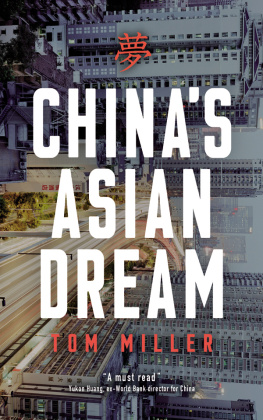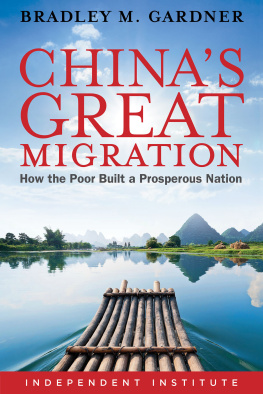Asian Arguments
Asian Arguments is a series of short books about Asia today. Aimed at the growing number of students and general readers who want to know more about the region, these books will highlight community involvement from the ground up in issues of the day usually discussed by authors in terms of top-down government policy. The aim is to better understand how ordinary Asian citizens are confronting problems such as the environment, democracy and their societies development, either with or without government support. The books are scholarly but engaged, substantive as well as topical and written by authors with direct experience of their subject matter.
About the Author
TOM MILLER is managing editor of the China Economic Quarterly, published by research company GK Dragonomics, and a former Beijing correspondent of the South China Morning Post. Tom has a degree in English from Oxford and an MA in Chinese Studies from the School of Oriental and African Studies in London. After teaching for a year at Shanghai University, he studied Chinese at Beijing Language and Culture University and at Chinas Central Academy of Drama. Resident in China for more than a decade, Tom lives in Beijing with his wife and two children. This is his first book.
CHINAS URBAN BILLION
The story behind the biggest migration in human history
_____________
TOM MILLER
Zed Books
LONDON | NEW YORK
Chinas Urban Billion: The Story behind the Biggest Migration in Human History was first published in 2012 by Zed Books Ltd, 7 Cynthia Street, London N1 9JF, UK and Room 400, 175 Fifth Avenue, New York, NY 10010, USA
This ebook edition was first published in 2012.
www.zedbooks.co.uk
Copyright Tom Miller 2012
The right of Tom Miller to be identified as the author of this work has been asserted by him in accordance with the Copyright, Designs and Patents Act, 1988
Designed and typeset in Monotype Bulmer
by illuminati, Grosmont
Index by John Barker
Cover designed by www.alice-marwick.co.uk
All rights reserved. No part of this publication may be reproduced, stored in a retrieval system or transmitted in any form or by any means, electronic, mechanical, photocopying or otherwise, without the prior permission of Zed Books Ltd.
A catalogue record for this book is available from the British Library
Library of Congress Cataloging in Publication Data available
ISBN 978 1 78032 144 8
for Jesse Burke, 19742012
Acknowledgements
This book can trace its origins to a conversation with Dakis Hagen on a road somewhere between Cape Town and Port Elizabeth in June 2010, during the first week of the football World Cup in South Africa. Dakis told me it was about time I got off my backside and wrote a book. I put this idea to a friend and China author. You should write one, he said. But be warned: writing books ends in divorce.
A few months later, I was in Paul Frenchs office in Shanghai blagging contacts for an article I was researching about Chinese retail. He mentioned he was looking for writers to contribute to a new series, to be called Asian Arguments, for Zed Books in London. Ill write one, I said, without thinking. All right, Paul said. Send me a proposal. Three months later, I had a deal.
I do not intend to write an exhaustive list thanking everyone who had a hand, either directly or indirectly, in shaping Chinas Urban Billion. But it is appropriate to thank the people who were there in the beginning: Dakis Hagen and Paul French. In particular, I owe a debt of gratitude to Paul, who pushed my book from the start and was a supportive presence throughout the publishing process. And I must also thank my commissioning editors at Zed, Jakob Horstmann and Tamsine ORiordan, for taking a punt on a first-time author and getting the book out so quickly.
The following people helped make the book happen: Chris Buckley, David Cowhig, Peter Foster, Peter Goff, Fergus Naughton and Konrad Shek. Valuable contributions were made by my colleagues at GK Dragonomics, especially Will Freeman, Alanis Qin, Rosealea Yao and Janet Zhang. I also benefited enormously from the discussions on Rick Baums CPol listserv, which pointed me towards sources I otherwise would not have found. I am especially grateful to Andrew Batson, Kam Wing Chan, Matt Forney, Jes Nielsen and David Wilder, who read and commented on the draft manuscript. And special thanks are due to the dozens of people all over China who were so generous with their time especially Chen Fangyan, Yu Changjiang and all the Li family in Dazhangshan.
On a personal as well as professional note, I owe a special debt of gratitude to Arthur Kroeber, my boss at GK Dragonomics. Back in 2004, Arthur took the unfathomable decision to hire an innumerate literature graduate with no prior interest in economics or business to report on, comically enough, economics and business. Without him, this book could never have been written. On a purely personal note, manly hugs go to all the Footy Boys (you know who you are) and Sausage Club (ditto) for keeping me sane in Beijing with beer and vulgarity.
And, finally, the biggest thanks of all go to Flora simply for being there. The book is finished and I am still married. What more could a man ask?
Tom Miller
Beijing, May 2012

INTRODUCTION
The Biggest Migration in Human History
The journey from farm to city is the story of Chinas transformation from a poor and backward country to a global economic superpower. By 2030, when Chinas urban population is projected to swell to 1 billion, its cities will be home to one in every eight people on earth. How Chinas urban billion live will shape the future of the world.
Nowhere is Chinas urban miracle more obvious than in Chongqing, the largest city on the upper reaches of the Yangtze River. Once a rusting laggard, marooned far from the dynamic cities of the eastern seaboard, this rough-and-ready river port is undergoing a spectacular transformation. Over the past decade, hundreds of towering apartment blocks have sprouted from the citys deep red soil, and new bridges have soared across its muddy river banks. The skyline, a thicket of skyscrapers, already resembles Hong Kongs. Yet the construction frenzy shows no sign of slowing: entering Chongqing is like walking into a giant building site. On the citys northern outskirts, bulldozers flatten wooded hills and lush ravines to satisfy property developers insatiable appetite for land. Near the airport, teams of construction workers lay track on a new monorail, which will eventually run to nine lines. And at the heart of the old city, wreckers armed with pickaxes hack at a tangle of grimy slums.
Chongqing municipality is often wrongly called the worlds largest city. It is actually a mostly rural city-province a little larger than Scotland, with a resident population of 28 million. Around one-quarter of these people live in the city proper, which is rapidly expanding to accommodate an enormous influx of new urban residents. By 2020, planners expect the citys population to top 12 million. A model of central Chongqing at the municipal planning centre shows a sea of skyscrapers and smart residential compounds dappled by green, verdant spaces. Accompanying captions confidently proclaim that six big cities, twenty-five smaller cities and 495 towns will surround the core megacity, just as many stars encircling the moon. In the local governments cosmic view of their citys development, A new Chongqing is galloping to the world.










